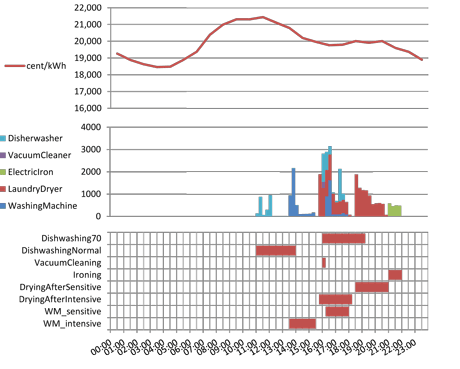by Armin Wolf, Thomas Luckenbach and Mario Schuster
The threat of global climate change and the challenge of reducing carbon emissions necessitate new ways to collaboratively manage and optimize energy production and load. Home and living areas can be part of such an approach thanks to secured and standardized smart metering environments.
The availability of renewable energy fluctuates heavily. Because of the stochastic nature of energy production, energy consumption should follow its production. The introduction of time-variable energy tariffs is an approach to attract consumers to shift their energy loads into low demand periods. We have developed a smart energy management system that reacts to flexible electricity prices. The system optimally schedules electricity consumers, minimizing the overall energy cost while respecting device-specific load profiles and individual constraints defined by the user. According to a recent study on demand side integration, there is the potential to load shift more than 10 GW in private households in Germany [1].
The core of the realized energy optimization system comprises a constraint-based scheduler that schedules the load profiles of the considered electricity consumers on a common cost aware cumulative resource [2], respecting temporal constraints (eg washing before laundry drying) and capacity restrictions (eg determined by the main fuse). Therefore, the system receives the energy tariff for the considered scheduling horizon – typically 24 hours with fixed prices for a time resolution of 15 minutes – as well as the load profiles to be scheduled, the overall capacity level which must not be exceeded, and the temporal constraints on the load profile. The load profiles are represented by discrete pricewise constant functions showing the average power demand of an electricity consumer per time unit during its usage which has to be scheduled. The chosen time resolution depends on the application domain – typical resolutions are five or 15 minutes according to the tariff information. For instance, a typical dish washer has a low power demand while pre-/post-rinsing (eg 200 W) but has a high power demand during the washing/drying phase (eg 1 kW) such that a naive management approach, which starts dish-washing when the energy price is low, may not be the most economical option since the energy intensive part of the cycle might occur within the high-price period. The temporal constraints allow the formulation of:
- time slots, ie earliest start and latest completion times of the energy loads,
- mutual exclusions of several loads, eg caused by the same device or requiring an additional but exclusively available resource, eg an operator,
- temporal relationships between the start and end times of different loads, eg “before”, “while”, “after”, “earliest”, or “latest” conditions.
The system transforms this kind of input data and constraint definitions (defined in XML) into a mathematical, constraint optimization problem using a Constraint Programming (CP) approach. Our constraint-solving library “firstCS” [3] offers the necessary primitives and Operations Research (OR) functionality to define and solve the necessary equalities and inequalities resulting from variable tariffs as well as the temporal and capacitive restrictions. The achieved solution consists of two parts: a cost-minimal schedule of the loads and the according load distribution. Again, the output is in XML format. In particular, for the load distribution the interface standard for meter reading and control, IEC 61968-9, is used. We have chosen this format for easy comparison of the scheduled load with the real energy consumption measured by smart meters. These data in the same format show the difference between target and reality as well as the financial loss compared to the cost-optimal schedule. In order to perform the necessary analysis and perform a comfortable automatic control of the involved devices (causing the loads), the energy management system can run on our own energy management and control gateway.

Figure 1: Example of a dynamic load management based on individual preferences and load profiles of typical devices
This gateway is a programmable communication device that can take over the role of a gateway for Controllable Local Systems (CLS) to allow electrical devices to be switched based on the current load management. The CLS approach is also specified in the German guidelines for smart metering systems and gateways and the respective protection profile [4]. Additional software modules of our gateway enable demand side integration (eg our smart energy management) and load control. For comfortable use, the gateway offers a unified web-based user-interface on PC, appliances, and smartphones (using HTML5). The solution is an open interoperable gateway having a standardized interface to access certified smart meter gateways (SMGW), smart meters, and other machine-to-machine (M2M) devices. It also supports state-of-the-art home automation and facility control technologies such as digitalSTROM, KNX, ZigBee and 868MHz RF.
References:
[1] Demand Side Integration – Lastverschiebungspotenziale in Deutschland, VDE-ETG-Studie, June 2012
[2] H. Simonis and T. Hadzic: “A resource cost aware cumulative”, in proc. ModRef 2010 workshop at CP 2010
[3] A. Wolf: “firstCS – New Aspects on Combining Constraint Programming with Object-Orientation in Java”. KI – Künstliche Intelligenz, vol. 26, no. 1, 2012
[4] Federal Office for Information Security, Protection Profile for the Gateway of a Smart Metering System, Gateway PP, v01.01.01(final draft), 25.08.2011.
Please contact:
Armin Wolf
Fraunhofer FOKUS, Germany
Tel: +49 30 6392 1864
E-mail:
Thomas Luckenbach
Fraunhofer FOKUS, Germany
Tel: +49 30 3463 7245
E-mail:
Mario Schuster
Fraunhofer FOKUS, Germany
Tel: +49 30 3463 7302
E-mail:











